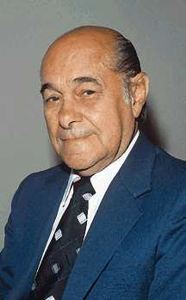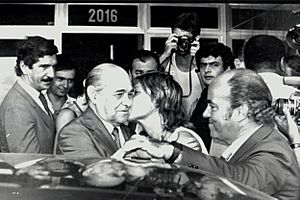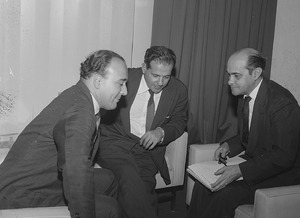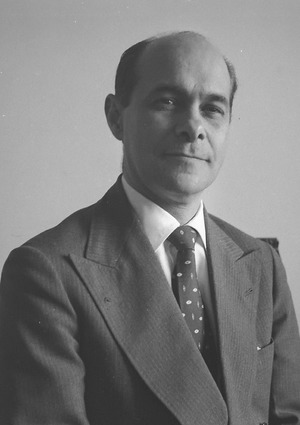Tancredo Neves facts for kids
Quick facts for kids
Tancredo Neves
|
|
|---|---|

Neves before 1985's elections
|
|
| President-elect of Brazil | |
| In role 15 March 1985 – 21 April 1985 |
|
| Vice President | José Sarney |
| Preceded by | João Figueiredo |
| Succeeded by | José Sarney |
| Prime Minister of Brazil | |
| In office 8 September 1961 – 12 July 1962 |
|
| President | João Goulart |
| Preceded by | Office re-established |
| Succeeded by | Brochado da Rocha |
| Governor of Minas Gerais | |
| In office 15 March 1983 – 14 August 1984 |
|
| Vice Governor | Hélio Garcia |
| Preceded by | Francelino Pereira |
| Succeeded by | Hélio Garcia |
| Senator for Minas Gerais | |
| In office 1 February 1979 – 15 March 1983 |
|
| Preceded by | Magalhães Pinto |
| Succeeded by | Alfredo Campos |
| Member of the Chamber of Deputies | |
| In office 3 February 1963 – 1 February 1979 |
|
| Constituency | Minas Gerais |
| In office 30 August 1954 – 1 February 1955 |
|
| Constituency | Minas Gerais |
| In office 12 March 1951 – 25 June 1953 |
|
| Constituency | Minas Gerais |
| Minister of Justice and Internal Affairs | |
| In office 26 June 1953 – 24 August 1954 |
|
| President | Getúlio Vargas |
| Preceded by | Negrão de Lima |
| Succeeded by | Miguel Seabra Fagundes |
| Member of the Legislative Assembly of Minas Gerais | |
| In office 1 August 1947 – 12 March 1951 |
|
| Constituency | At-large |
| Personal details | |
| Born |
Tancredo de Almeida Neves
4 March 1910 São João del-Rei, Minas Gerais, Brazil |
| Died | 21 April 1985 (aged 75) São Paulo, São Paulo, Brazil |
| Political party |
|
| Spouse |
Risoleta Guimarães Tolentino
(m. 1938) |
| Children | 3 |
| Alma mater | UFMG School of Law |
| Signature | |
Tancredo de Almeida Neves (March 4, 1910 – April 21, 1985) was an important Brazilian politician, lawyer, and businessman. He held many key positions in the government. He was the Minister of Justice from 1953 to 1954. Later, he served as Prime Minister from 1961 to 1962. He also became Governor of Minas Gerais from 1983 to 1984.
In 1985, Tancredo Neves was chosen to be the President of Brazil. However, he became very ill and sadly passed away before he could officially start his term. Even so, he is remembered as a crucial figure in Brazil's return to democracy.
Contents
Who was Tancredo Neves?
Tancredo Neves was born in São João del-Rei, a city in Minas Gerais, Brazil. His family had roots in Portugal and Austria. He studied law and became a public prosecutor in 1933.
He married Risoleta Guimarães Tolentino in 1938. They had three children together. One of his grandsons, Aécio Neves, also became a well-known politician.
How did Tancredo Neves start in politics?
Tancredo Neves began his political journey in his hometown. In 1935, he was elected as a city councilman in São João del-Rei. He even became the president of the City Council.
In 1947, he was elected to the state legislature of Minas Gerais. Three years later, he became a representative in the Brazilian Chamber of Deputies.
Serving as Minister of Justice
In 1953, President Getúlio Vargas appointed Neves as the Minister of Justice. He served in this role until 1954. He resigned after a major political crisis.
Neves remained loyal to Vargas's memory. He helped Juscelino Kubitschek become a candidate for president in 1955.
What was his role as Prime Minister?
In 1961, Brazil faced a big political challenge. President Jânio Quadros resigned, and there was a risk of a military takeover. To prevent this, a new system called parliamentarism was introduced. This system reduced the president's power.
Tancredo Neves was chosen as the new Prime Minister on September 8, 1961. His job was to lead the government under this new system. He worked to bring different political groups together.
During his time as Prime Minister, Neves focused on important issues. These included economic problems and the need for social changes like land reform. He tried to find solutions that would make everyone happy.
However, the country still faced many challenges. There were protests about high prices and low wages. In June 1962, Neves and his cabinet resigned. He was then re-elected as a congressman.
How did he oppose the Military Government?
After a military coup in 1964, a military government took power in Brazil. Tancredo Neves was one of the few politicians who continued to support the deposed President João Goulart.
He did not lose his political rights, unlike many others. This was because he had good relationships with some military leaders.
Neves joined the Brazilian Democratic Movement (MDB), which was the main opposition party. He was re-elected as a congressman several times. He was known for being a moderate voice within the opposition. He tried to avoid direct conflicts with the military government.
In 1978, he was elected as a senator for Minas Gerais. When Brazil started to allow more political parties again, Neves founded the Popular Party (PP) in 1980.
Becoming Governor of Minas Gerais
In 1982, Neves joined the Brazilian Democratic Movement Party (PMDB). He was then elected Governor of Minas Gerais. He served from 1983 to 1984.
During his time as governor, a big movement called Diretas Já (Direct Elections Now) grew across Brazil. This movement demanded that citizens should directly vote for the president.
The "Diretas Já" Movement and the 1985 Election

In 1983, discussions began about who would replace President João Figueiredo. Many people wanted direct elections. However, the government planned for the president to be chosen by an electoral college (a group of elected officials).
Tancredo Neves became a strong candidate for president. He was supported by many opposition parties. He also gained support from some members of the ruling party who disagreed with their own candidate.
Neves participated in large public rallies for the "Diretas Já" movement. In April 1984, he spoke to over 1.5 million people in São Paulo. He said it was time to free Brazil from the problems of the past 20 years.
Even though the "Diretas Já" amendment was not approved, Neves continued his campaign. He formed an alliance with José Sarney, who became his running mate for vice-president.
On January 15, 1985, Tancredo Neves was elected president by the Electoral College. He received many more votes than his opponent. His victory was a huge moment for Brazil, marking the end of the military government.
Illness and Passing Away
After his election, Tancredo Neves traveled abroad to meet with other world leaders. He was preparing to take office. However, he started to feel severe stomach pain.
He was advised to get medical treatment, but he wanted to wait until after his inauguration. He worried that if he announced his illness, it might cause problems for Brazil's return to democracy. He wanted to make sure the new government would start smoothly.
On March 14, 1985, the day before his inauguration, Neves became very ill. He was rushed to the hospital. Doctors later said he had a serious infection.
Because of his illness, Vice President José Sarney had to take over as acting president on March 15, 1985. Neves had several surgeries but his health continued to worsen.
Tancredo Neves passed away on April 21, 1985, at the age of 75. He never officially took office as president. His death caused great sadness across Brazil.
His funeral was one of the largest in Brazil's history. Millions of people came to pay their respects. Even though he didn't serve as president, a law was passed to include his name in the gallery of Brazilian presidents.
What is Tancredo Neves's Legacy?
Tancredo Neves is remembered as one of Brazil's most important politicians of the 20th century. He played a key role in bringing democracy back to the country after years of military rule.
He was known for his ability to bring people together and find solutions. In 2012, he was voted one of the "100 Greatest Brazilians of All Time."
Many places in Brazil are named after him. These include a city in Bahia, a major avenue in Salvador, and the Tancredo Neves International Airport in Belo Horizonte. The Tancredo Neves Bridge connects Brazil and Argentina.
His life and political journey have been featured in books and documentaries. His story continues to inspire people about the importance of democracy and leadership.
Images for kids
-
Aécio Neves speaking about Tancredo Neves
-
Neves (then Governor of Minas Gerais) with his maternal grandson Aécio in 1983
See also
 In Spanish: Tancredo Neves para niños
In Spanish: Tancredo Neves para niños






